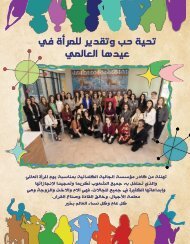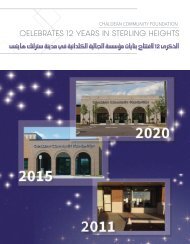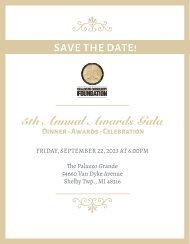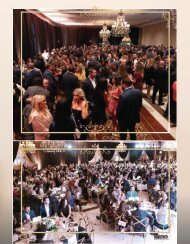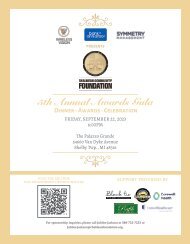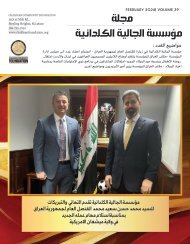You also want an ePaper? Increase the reach of your titles
YUMPU automatically turns print PDFs into web optimized ePapers that Google loves.
GUEST COLUMN<br />
The Suraye Declaration of Unity: Chaldeans,<br />
Assyrians, Syriacs, & Maronites Unite<br />
There is a tale of a oncefractured<br />
group of<br />
people with thirteen<br />
different identities, thirteen<br />
flags, thirteen different currencies,<br />
and thirteen states.<br />
They were all once divided,<br />
yet they were all one people.<br />
The British army exploited<br />
their differences and used<br />
their divisiveness to oppress<br />
them. One day, the divided<br />
group of people decided<br />
enough was enough. They gathered in<br />
a hot room on a summer day—July 4th,<br />
1776, to be exact—and decided to focus<br />
on their similarities and ignore their<br />
differences. They made a long list of everything<br />
they agreed on, which became<br />
the Declaration of Independence.<br />
With their newfound unity, the thirteen<br />
colonies had the strength to overwhelm<br />
the might of the British military,<br />
which was the strongest military in the<br />
world at that time. Eventually, the thirteen<br />
colonies transformed into the fifty<br />
United States. While our Middle Eastern<br />
ancestors for the last five centuries<br />
were busy complaining about different<br />
identities, young nations like America<br />
became united and powerful.<br />
The division brought us to the<br />
point of near extinction. Every generation<br />
before ours focused on our differences<br />
and ignored our similarities. On<br />
December 16, 2022, we reached a turning<br />
point. Four names, four flags, and<br />
five patriarchs united under a single<br />
identity: Suraye.<br />
Suraye can be defined as a group<br />
of Middle Eastern Christians linguistically<br />
rooted in Aramaic.<br />
Aramaic consists of two major subgroups,<br />
Eastern Aramaic and Western<br />
Aramaic. These subgroups split further<br />
into different dialects. The Eastern subgroup<br />
consists of the Chaldean (Sureth)<br />
dialect and Assyrian (Surayt and Urmian)<br />
dialects. There are also southern dialects<br />
of Aramaic spoken by Mandeans,<br />
who are followers of John the Baptist.<br />
The differences between the dialects<br />
lie in pronunciation and loan<br />
words from surrounding majorities,<br />
CHRIS SALEM<br />
SPECIAL TO<br />
THE CHALDEAN<br />
NEWS<br />
Suraye in Eastern Aramaic<br />
looks like this:<br />
such as Kurds, Turks, Arabs,<br />
and Persians. Every subgroup<br />
in the Eastern dialect uses the<br />
word “Shlama” to greet people,<br />
although it technically<br />
means “peace.” In the Western<br />
subgroups, the general<br />
rule is to pronounce almost<br />
every letter ‘A’ like it is the letter<br />
‘O’. As a result, they greet<br />
people by saying “Shlomo”<br />
instead of “Shlama”.<br />
For more than 500 years,<br />
the Chaldean and Assyrian churches<br />
were at odds with one another. One<br />
thousand years before that, the Syriacs<br />
were the first to splinter off. Shortly<br />
after, the Syriacs were further divided<br />
into Catholic and Orthodox subgroups.<br />
For the first time in at least five centuries,<br />
the five Patriarchs from these<br />
groups came together and jointly declared<br />
five “issues of common interest”<br />
that we are one people with one history,<br />
language, heritage, and shared identity.<br />
They plan to use their combined<br />
power to save and protect our identity.<br />
The five “issues of common interest”<br />
are: (1) Syriac spirituality; (2) the<br />
Syriac presence in the Middle East<br />
and pastoral challenges; (3) the Syriac<br />
presence in the diaspora; (4) partnership<br />
in testimony; and (5) the common<br />
Syriac heritage. The diaspora is<br />
any land inhabited by a group outside<br />
their original homeland.<br />
These five Patriarchs have made<br />
history. The last generation that could<br />
not set aside their differences will forever<br />
be remembered as the last generation<br />
that failed.<br />
Notably missing were the Patriarchs<br />
of the Melkite Church and the Ancient<br />
Church of the East, both of whom are<br />
linguistically rooted in Aramaic.<br />
The Patriarchs emphasized the<br />
importance of the ancient Suraye<br />
heritage that unites us and constitutes<br />
a rich sacred historical inheritance<br />
stemming from their historical unity,<br />
single Sureth language, and common<br />
church and liturgical rites. They established<br />
a committee to help preserve<br />
the language at an academic level<br />
worldwide.<br />
The Patriarchs reaffirmed their<br />
commitment to preserving and spreading<br />
this heritage and emphasized the<br />
importance of cooperation among the<br />
churches at various levels. They also<br />
made plans to establish a committee<br />
to work out church and liturgical differences,<br />
which could pave the way for<br />
one united Church.<br />
The statement also touches on the<br />
ongoing challenges faced by the Syriac<br />
community in the Middle East, particularly<br />
the issue of migration caused by<br />
conflicts and difficult living conditions.<br />
The Patriarchs expressed their determination<br />
to continue to support and care<br />
for their spiritual children in these regions<br />
and to work towards reducing the<br />
negative effects of migration.<br />
The statement also highlights the<br />
concerns of the Patriarchs regarding<br />
the dispersion of their flock in diaspora<br />
countries and their determination<br />
to continue to support and care for<br />
them, despite the distance.<br />
The Patriarchs further emphasized<br />
the importance of transmitting the<br />
Syriac heritage and culture to future<br />
generations and stressed the role of the<br />
churches in providing spiritual guidance<br />
and support to the communities.<br />
They outlined a specific plan of action<br />
in a joint statement and called for<br />
cooperation and collaboration among<br />
the churches. Working together to support<br />
the presence of our communities<br />
in the Middle East, and working together<br />
to preserve and spread our culture<br />
and heritage.<br />
Our ancient culture and heritage<br />
are our anchors, rooted in the very<br />
soil of our ancestors. It is a legacy<br />
that must be cherished, protected,<br />
In Western Aramaic,<br />
it is written like this:<br />
and passed on to future generations.<br />
Through unity, our culture and heritage<br />
will stay intact. We must work<br />
together to preserve and spread it, to<br />
keep the light of our faith bright.<br />
This heritage shapes us, it is the<br />
glue that holds our communities together<br />
and our birthright. But without<br />
cohesion, this heritage is at risk of fading<br />
away, lost in history. Together, we<br />
must work to nurture it, amplify its<br />
message, and keep the light of our faith<br />
shining. The Patriarchs have pointed<br />
the way by calling for cooperation and<br />
collaboration among the churches.<br />
They remind us that our heritage<br />
is a precious inheritance that must be<br />
defended and passed on with care.<br />
Chris Salem and his wife Ranna are cofounders<br />
of Nineveh Rising, a non-profit<br />
dedicated to preserving the culture of<br />
people that live in the Nineveh Plain,<br />
Iraq, and helping Christians worldwide<br />
survive and thrive.<br />
8 CHALDEAN NEWS <strong>FEBRUARY</strong> <strong>2023</strong>








